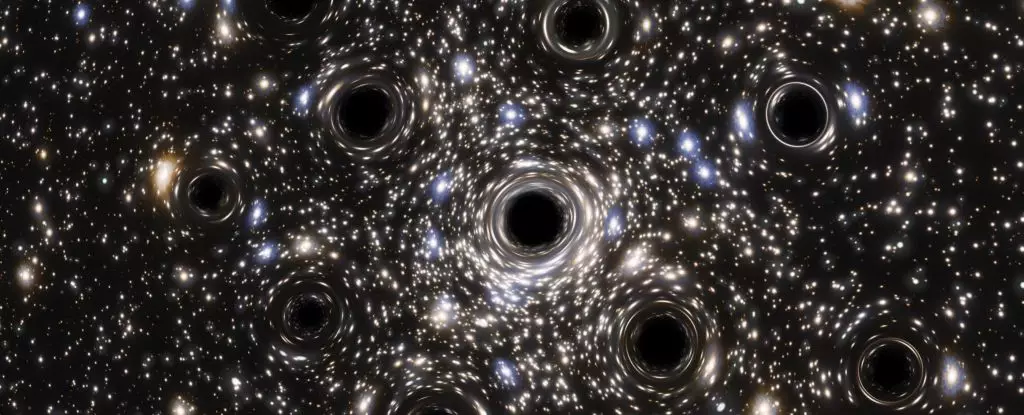In the vast expanse of the Milky Way galaxy, Omega Centauri stands as a remarkable globular cluster, approximately 17,000 light-years away from Earth. It has been shrouded in mystery, primarily due to its dense composition and the gravitational forces that govern it. Recently, astronomers have deepened our understanding of this celestial body by identifying not just one but possibly a multitude of stellar-mass black holes that reside within it. This groundbreaking finding challenges earlier assumptions that Omega Centauri housed a solitary black hole, an entity far larger than what the evidence now suggests.
Astrophysicist Andréas Banares Hernández, alongside his team from the Institute of Astrophysics of the Canary Islands, posits that this unexpected conclusion is pivotal. “We have long been aware of the existence of supermassive black holes in the centers of galaxies and smaller stellar-mass black holes populating our own galaxy,” he explains. “However, the presence of intermediate-mass black holes (IMBHs), which could serve as the missing link between these two types, is yet to be definitively established.” This revelation not only supports ongoing research into Omega Centauri but also opens intriguing avenues for comprehending the formation and evolution of galaxies.
The Role of Globular Clusters in Galactic Evolution
Globular clusters like Omega Centauri are significant because they can provide insights into the lifecycle of galaxies. Borne from the remnants of dwarf galaxies, such as the now-absorbed Gaia Sausage, Omega Centauri is essentially a compressed archive of stellar evolution. Scientists believe that, while full-sized galaxies typically harbor supermassive black holes at their centers, dwarf galaxies might host these elusive IMBHs, which exist on a continuum between stellar-mass and supermassive black holes.
The search for IMBHs, measuring between 100 and 1 million solar masses, has always been fraught with challenges. The indirect nature of identifying these entities often makes confirmation elusive. Black holes are notoriously silent, only betraying their presence under specific conditions, mainly when they consume surrounding matter. Thus, understanding their role in the cosmos often hinges on analyzing star movements.
Astronomers have been keenly observing the dynamics of stars within Omega Centauri, seeking evidence that suggests an invisible gravitational influence—potentially an IMBH at its core. A pivotal study has recently analyzed the data more critically, estimating the hidden mass at about 8,200 solar masses, falling within the hypothesized range for IMBHs. But this still leaves room for debate.
In an effort to clarify the situation regarding the cluster’s mysterious mass, Hernández’s research team introduced an innovative consideration—pulsars. These rapidly spinning neutron stars, renowned for emitting beams of high-energy radio waves, can be used to refine gravitational measurements due to the precision with which their rotational patterns can be tracked.
By examining the accelerations and positions of these pulsing stars, research indicates that the peculiar motion of stars at the center of Omega Centauri aligns more consistently with the presence of numerous stellar-mass black holes, rather than a single monolithic entity. This understanding does not preclude the existence of an IMBH, suggesting a more intricate cosmic relationship where both black hole categories might coexist. Stellar-mass black holes could, in fact, be gravitationally tethered to a central IMBH, forming a complex ecosystem shaped by their interactions.
The implications of these findings resonate beyond just Omega Centauri. They propel the ongoing quest to decipher the mechanics behind black hole formation and evolution within galaxies. By establishing a scenario in which stellar-mass black holes congregate under the influence of an IMBH, astronomers can better understand the processes that give rise to larger black hole structures over cosmic time.
As the search for intermediate-mass black holes continues, researchers remain optimistic. Each new piece of data chisels away at the enigma surrounding these cosmic giants. What we learn from Omega Centauri and similar clusters may well provide the key to understanding how black holes scale up and the roles they play in shaping the cosmos.
While Omega Centauri is not merely a container of passed cosmic history, it remains a significant research focal point. As the dialogue around its stellar-mass black holes expands, we draw closer to appreciating the complexities of black hole formation—a challenge that will persist as long as we gaze into the starlit night.

